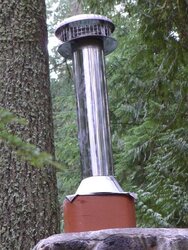Hi,
I've had a consistent drips from all over the inside of my huge stone fireplace that houses my new Avalon Rainier and chimney liner (I hope the photo is attached). I have not been using the stove this past winter due to access problems from unusually heavy snow, and due to reticence about the water coming down. The context There are some issues with snow damming against the chimney and the chimney flashing, but the drip continued this past weekend even with the snow gone and just intermittent rain showers. I'm wondering if this might be condensation since the stone stays cold even when the room starts to warm up? The cabin sits empty and cold most of the time, in a humid forest environment.
I also found my stove had standing water in it when I tried to light it this weekend. There are also some issues with sealing of the storm collar on the chimney extension that could account for water getting into the stove, or could it be due to condensation too?
Other than fixing the flashing, what else should I be doing? Is a dehumidifier in order, and will it work in cool air?
Thanks for any insights!
Jeff
I've had a consistent drips from all over the inside of my huge stone fireplace that houses my new Avalon Rainier and chimney liner (I hope the photo is attached). I have not been using the stove this past winter due to access problems from unusually heavy snow, and due to reticence about the water coming down. The context There are some issues with snow damming against the chimney and the chimney flashing, but the drip continued this past weekend even with the snow gone and just intermittent rain showers. I'm wondering if this might be condensation since the stone stays cold even when the room starts to warm up? The cabin sits empty and cold most of the time, in a humid forest environment.
I also found my stove had standing water in it when I tried to light it this weekend. There are also some issues with sealing of the storm collar on the chimney extension that could account for water getting into the stove, or could it be due to condensation too?
Other than fixing the flashing, what else should I be doing? Is a dehumidifier in order, and will it work in cool air?
Thanks for any insights!
Jeff


![photo_3476[1].jpg](/talk/data/attachments/8/8504-d0ee0ac9829a8f3478f2b6d2be1611df.jpg)
